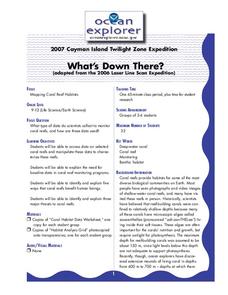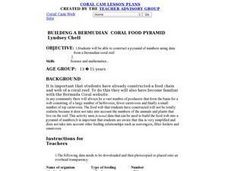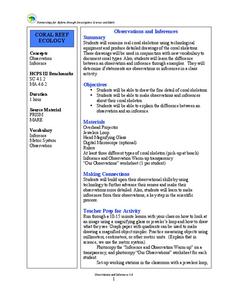Curated OER
Corrosion to Corals
Students study galvanic exchange and how it produces electric currents. In this ocean lesson students predict what metals deteriorate in salt water.
Curated OER
Deep Gardens
Marine biology beginners read about the 2005 Florida Coast Deep Corals expedition, research phylum Cnidaria, and then report on a specific coral deep-sea coral group. There is an abundance of background information and internet resources...
Curated OER
Treasures in Jeopardy
In small groups, middle schoolers research deep-sea coral reefs and design a poster to educate the public about their importance. They compare them to shallow-water reefs and consider the impact of bottom-trawl fishing. Many internet...
Curated OER
Corals and Coral Reefs
Students label the continents, oceans, and seas on a provided world map and use it to determine where they would expect most of the world's coral reefs to be found based on provided information the teacher has read to them.
Curated OER
Feeding in the Flow
Students examine current flow and describe ways in which it may effect food of reef building corals. In this coral lesson students identify two environmental factors that may affect the morphology.
Curated OER
Mealtime for Corals
Students explore how coral polyps feed. In this science lesson plan, students participate in an interactive game to demonstrate how polyps within a coral colony feed. Students become coral polyps and demonstrate how they feed in this...
Florida International University
Design Your Own
Apply scientific principles to designing an experiment to study organisms living on the coral reef in our oceans. Through reading, individuals learn about the coral reef ecosystem and important factors that affect its function. Using the...
Curated OER
Coral Bleaching
Students examine the relationship between corals and zooxanthellae, identify stresses to corals, and explain coral bleaching. In this sea life instructional activity students predict the effects of increased temperatures on coral reefs.
Curated OER
Lesson #5: Symbiosis and Coral Anatomy
Fifth graders examine the basic structure of corals and the concept of symbiosis. They watch a Powerpoint Presentation, develop an original pair of organisms living symbiotically, and create an edible model of a coral polyp.
Florida International University
Are You Concentrating?
Explore the importance of a concentration gradient in the rates of dissolution. Using the ocean ecosystem, learners study rates of dissolution around coral reefs. A hands-on experiment helps individuals discover the effects of changing a...
Curated OER
Deep Gardens
Students compare and contrast deep-sea coral reefs with shallow-water coral reefs. In this underwater ecology lesson, students describe three types of coral and explain why scientists are concerned about the future of deep-sea coral.
Curated OER
What's Down There
Students write an essay about the coral reefs. In this oceanography lesson, students investigate the reef of Bonaire and compare it to reefs that are not thriving. Students then explore the differences that contribute to the overall...
NOAA
Biological Oceanographic Investigations – Call to Arms
How many simple machines does it take to make a robotic arm? An inquiry-based activity explores that topic and challenges pupils to build a robotic arm that can stretch, turn, and more. A few questions help guide them in the right...
Biology Junction
Cnidarians and Ctenophorans
Cnidaria is a broad phylum of 11,000 different species from jellyfish to coral. Most Cnidarians are marine species with a few freshwater examples. A lesson presentation explains the important characteristics of different species of both...
Curated OER
Feeding in the Flow
The National Oceanic and Atmospheric Administration (NOAA) has developed a tremendous library of ocean-themed lessons that can be used in a variety of science settings. "Feeding in the Flow" is one of those activities; Its focus is on...
Curated OER
Making an Edible Coral Polyp
Students study anatomy. For this coral reef lesson, students recreate the anatomy of a coral polyp using edible materials. They work in pairs following step-by-step instructions given by the teacher. This lesson includes a list of...
Curated OER
Coral Reefs
Students research an inhabitant of a Caribbean coral reef using a list of common organisms that live on or near it. Students then write a description of their organism and draw a picture or a 3-D model of it. Eventually they all work...
Moorea Coral Reef Long-Term Ecological Research Program
Paper Plate Fishes
Tropical fish make great art projects! Use paper plates to design, color, and assemble round and oval-shaped fish based on photographs of actual fish found along the Moorea Coral Reef. Kids learn about different fins- including the...
Curated OER
What's Down There?
Students analyze data on coral reefs and use this to help characterize reefs. In this mapping coral reefs instructional activity students identify and explain the major threats to coral reefs.
Curated OER
Easy as Pi
Students describe the importance of structural features that increase surface area in a coral reef habitat. In this investigative lesson plan students quantify the impact of modifications on surface area in model habitats.
Curated OER
Science: Coral Reef Food Pyramid
Students construct numbers pyramids using fictional data from a coral reef. they tally the numbers of carnivores, herbivores, and producers. Students next build a pyramid shape in which they put their numbers of producers, herbivores,...
Curated OER
Observations and Inferences
Students examine coral skeletons. For this science lesson, view real coral skeletons. Students explain the differences between an observation and an inference. Students draw a coral skeleton.
Howard Hughes Medical Institute
Ocean Acidification
Human impacts on the environment can sometimes be difficult to measure, especially under water! An activity centered on ocean acidification gives science scholars the opportunity to examine the effects of carbon dioxide on marine life....
Curated OER
Call to Arms
Students explore how scientists build robotic arms that move similar to humans. In this robot lesson, students examine how scientists make robots. Students design and construct a mechanical arm that moves like a human arm. Students...

























